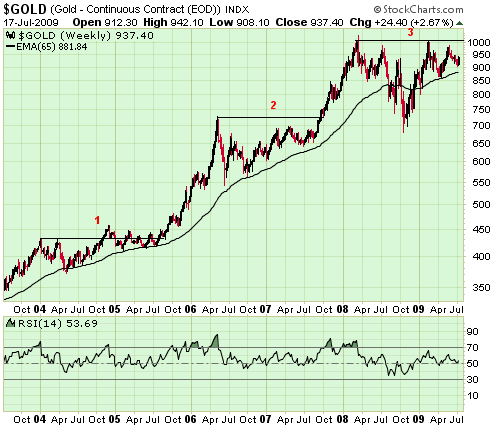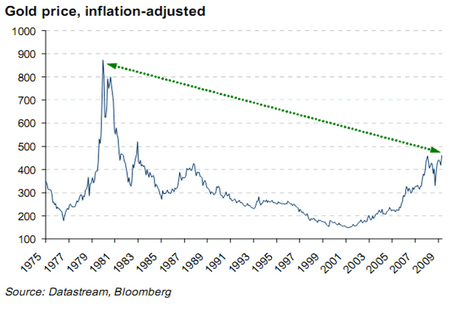In our articles and newsletters we regularly highlight gold's solid fundamentals.
- World financial/economic crisis may have culminated and greatest risks have been averted but it is still very far from over
- US dollar continues in its multi-year downtrend
- World governments are committed to issue huge volume of government debt for many years to come
- Quantitative easing—debt monetization—are becoming a routine practice of the Fed
- President Obama's plans for government spending are making Bush deficits seem like child's play
The list goes on and on. Most of gold bugs' economic projections made years ago have come true, but gold has been stuck at a seemingly impregnable level of $1,000 for almost 18 months. Will this level be overcome and when?

In our view, the current economic situation has three different outcomes:
1. Reflationary policies of the Fed and the government will return the economy to real growth of over 2.5%. The Fed will be able to pinpoint the exact moment of when monetary tightening will need to take place and carefully begin raising short term rates, sell government bonds and agencies' notes. Perfect, precise and proactive monetary policy will ensure price stability and relieve the threat of escalation in inflation.
In this scenario, a V-shaped recovery declared by the bulls will become reality. Stock market will soar and gold, after an initial attempt to rally, will likely fall below $700 per ounce.
2. In a huge deleveraging cycle, deflationary forces experienced by the banks, businesses and consumers will continue to prevail for the next several years. World economy will largely remain in a state of stagnation – Japanese style. Pockets of growth in the world will be insufficient to turn the rest of the world economy around.
In this scenario, it is likely that gold will remain in a wide trading range - $700 to $1000. Stock market will fall below the current bear market low targeting 400-500 on the S&P 500. Gold will grow in real terms (Gold against the S&P 500) but not in nominal terms. Profits will be good for existing low-cost gold producers but it will, nevertheless, be a tough environment for PM investors.
3. Central banks and governments will continue to inject borrowed money into the unhealthy and unproductive sectors of the economy. This will undoubtedly lead to an increased role of lobbyism and a diminished role of the private sector and market competition – the main forces of capitalism. The result is easily predictable: very low economic growth for an extended period of time.
Rising government debt and falling tax receipts, the growing role of the government and increased regulation will make political pressure on the Fed inevitable and overwhelming. Debt monetization, a crucial but only a "temporarily" measure, will become an overused practice.
Consequences of such a monetary policy will be downward pressure on the US dollar, inevitable rise in inflation expectations and an upward pressure on long term yields with growing concerns for fiscal sustainability.
With such an outcome of events, the stock market will remain at a depressed level, but the price of real assets—energy, food, metals—will rise. The main beneficiary will clearly be gold, which will begin a new phase of its bull market.
While all of the three scenarios are possible, in our view, the probability of the first is close to a likelihood of an economic miracle. In the near future, we see either the second or third scenario evolving (this is in general terms as it is never possible to predict an exact path of an economy).
In the context of elevated unemployment, the Administration and the U.S. Congress (which is starting to eye the 2010 elections), cannot allow themselves to stop stimulating the economy, cut spending and significantly raise taxes. Any attempt by the Fed to begin exiting its monetary easing strategy will prompt a renewed recession. All the talk of "exit strategy" will end as quickly as the stock market rally, prompting another deflation scare. As VP Joe Biden candidly stated: "We have to go spend money to keep from going bankrupt." That is why we believe that the third scenario is the most probable outcome for the US economy in the next few years.
The main question is when will inflationary expectations begin to rise causing a new stage of a gold bull market? The best answer we can give is as follows:
The lag between monetary expansion and price inflation in the United States is about 3.5 years. The Fed started bloating its balance sheet about a year ago. Therefore, price inflation could really begin showing its teeth toward 2012. However, inflation expectations are a different animal. In the context of a major concern for fiscal sustainability and a prolonged period of elevated money supply by the Fed, inflation expectations can explode much earlier. It is quite possible that this could happen as early as next year.

If gold matches the inflationary spike of the 1970s, then its prices should easily rise toward $2,000.
Boris Sobolev
Denver, Colorado
www.resourcestockguide.com





































